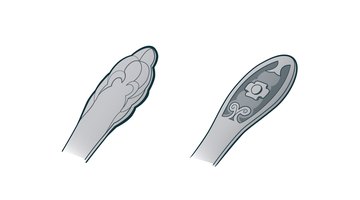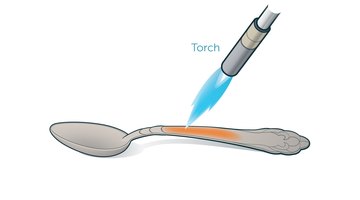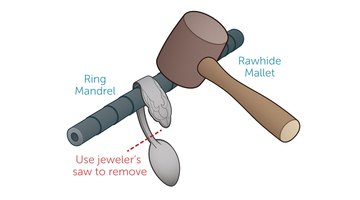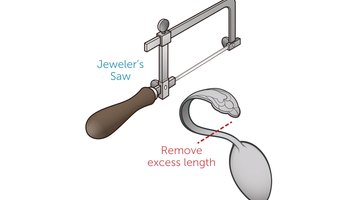Few types of jewellery possess the quirky charm of bracelets and rings than those that have been fashioned from recycled silverware. Silver spoons, forks and knives are unexpected materials with which to fashion jewellery. They make an impact, however, when they are removed from the traditional table setting in which they are most commonly seen and worn as adornments.
Obtain silver utensils that are made of solid silver, rather than silver-plated base metal. Note that solid silver utensils lend themselves to the process of heating, cutting and bending much better than silverware made of silver-plated base metal.
- Few types of jewellery possess the quirky charm of bracelets and rings than those that have been fashioned from recycled silverware.
- Obtain silver utensils that are made of solid silver, rather than silver-plated base metal.

Select a silver utensil that will make an appealing piece of jewellery. Consider using an antique silver spoon, which has soft, curvy lines that make it suitable for wearing against the skin. Opt for a piece of silverware that features an attractive embellishment, such as flowers or vines.

Heat, or anneal, the silver utensil by using a butane or propane torch. Annealing is a process that makes silver more pliable and easier to bend into new forms. Position the silverware on a heat-safe work surface. Move torch's flame back and forth over the surface of the utensil. When the silverware takes on a dull, red glow, remove the flame and turn off the torch.

Pick up the utensil with metal tongs. Drop the utensil into a bowl of cold water. Allow the utensil to cool completely before removing it from the water.
- Heat, or anneal, the silver utensil by using a butane or propane torch.
- Allow the utensil to cool completely before removing it from the water.
Position the utensil against a bracelet mandrel---a tapered, cylindrical form made of wood or metal that is used to form metal bracelets in various sizes---to make a silverware bracelet.

Strike the utensil with a rawhide mallet, which is a hammer used to form and bend metal without marring it, to bend the utensil around the circumference of the bracelet mandrel. Hammer the utensil repeatedly until it is completely wrapped around the bracelet mandrel and the two ends of the utensil nearly meet. Leave a gap between the two ends of the utensil that is large enough to slide the silverware bracelet on and off your wrist. Slide the utensil off the bracelet mandrel. It should form a cuff bracelet.
- Position the utensil against a bracelet mandrel---a tapered, cylindrical form made of wood or metal that is used to form metal bracelets in various sizes---to make a silverware bracelet.
- Strike the utensil with a rawhide mallet, which is a hammer used to form and bend metal without marring it, to bend the utensil around the circumference of the bracelet mandrel.

Position the handle portion of the utensil against a ring mandrel, which is a tapered, cylindrical form made of wood or metal that is used to form metal rings in various sizes, to make a silverware ring.
Strike the utensil with a rawhide mallet to bend it around the circumference of the ring mandrel. Hammer the stem portion of utensil repeatedly until it is completely wrapped around the bracelet mandrel.

Slide the utensil off the ring mandrel. Using a jeweller's saw, cut away any excess length from the utensil that you do not need to make the ring. You will cut away the bottom portion of the utensil along with part of the handle portion. Replace the ring back onto the mandrel and hammer it until two ends of the utensil meet smoothly. Slide the ring off the mandrel.
- Strike the utensil with a rawhide mallet to bend it around the circumference of the ring mandrel.
- Slide the utensil off the ring mandrel.
TIP
Polish your silverware jewellery with a silver polishing cloth to bring out its natural glow. You can often find old silverware at antique shops, thrift stores and estate sales. Where you position the silver utensil on the bracelet or ring mandrel will determine how large the finished bracelet or ring is. Mandrels are marked with lines that indicate sizes.
